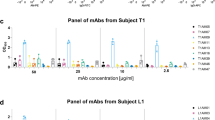Abstract
Earlier we reported that vaccination of leprosy patients withMycobacterium w induces an immune response directed predominantly against low molecular weight antigens. One of these antigens, with a molecular mass of 30-kDa, was recognized by a majority of the vaccinated subjects as well as the tuberculoid leprosy patients and healthy contacts. In the present communication we report further characterization of this antigen. Immunofluorescence and Western blot studies with antibodies raised against this antigen demonstrate that it is associated with the cell surface and has homologues present inM. leprae andM. tuberculosis. Delayed-type hypersensitivity studies carried out in guinea pigs immunized with the 30-kDa antigen show that in addition to sharing B cell determinants, this immunodominant antigen ofM. w also shares T cell determinants withM. leprae andM. tuberculosis.
Similar content being viewed by others
References
Abou-Zeid C, Ratliff TL, Wiker HG, Harboe M, Bennedsen J, Rook GAW (1988) Characterization of fibronectin-binding antigens released byMycobacterium tuberculosis andMycobacterium bovis BCG. Infect Immun 56:3046–3051
Alexander J, Curtis J (1979) Development of delayed hypersensitivity response inMycobacterium lepraemurium infection in resistant and suceptible strains of mice. Immunology 36:563
Cherayil BJ, Young RA (1988) A 28-kDa protein fromMycobacterium laprae is a target of the human T cell response in lepromatous leprosy. J Immunol 141:4370–4375
Convit J, Aranazazu N, Ulrich M, Reyes O, Alvarado J (1982) Immunotherapy with a mixture ofMycobacterium leprae and BCG in different forms of leprosy and in Mitsuda negative contacts. Int J Lepr 50:415–424
Das PK, Rambukkana A, Bass JG, Groothuis DG, Halperin M (1990) Enzyme-linked immunosorbent assay for distinguishing serological responses of lepromatous and tuberculoid leprosies to the 29/33-kilodalton doublet and 64-kilodalton antigens ofMycobacterium tuberculosis. J Clin Immunol 28:379–382
Deo MG, Bapat CV, Chulawala RG, Bhatki WS (1981) Potential of anti-leprosy vaccine from killed ICRC bacilli in a clinico pathological study. Indian Med Res 74:164–177
Fong TAT, Mosmann TR (1989) The role of interferon-γ in delayed-type hypersensitivity mediated by Th1 clones. J Immunol 143:2887–2893
Ganju L, Mukherjee R, Batra HV, Talwar GP (1990) Immunoblot analysis of antigens ofMycobacterium w, a candidate anti-leprosy vaccine using monoclonal antibodies and patient sera. Int. J Bacteriol Microbiol. Hyg. 273:378–385
Haanen JBAG, de Waal Malefijt R, Res PCM, Kraakman EM, Ottenhoff TMH, de Vries RR, Spits H (1991) Selection of human T helper type 1-like T cell subsets by mycobacteria. J Exp Med 174:583–592
Laemmli UK (1979) Cleavage of structural proteins during assembly of the head of bacteriophage T4. Nature 277:680–685
Lowry OH, Rosenbrough NJ, Farr AL, Randall RJ (1951) Protein measurement with the Folin-Phenol reagent. J Biol Chem 193:265–275
Mehra V, Bloom BR, Torigian VK, et al (1989) Characterization ofMycobacterium leprae cell wall-associated proteins with the use of T lymphocyte clones. J Immunol 142:2873–2878
Melacon-Kaplan J, Hunter SW, McNeil M, Stewart C, Modlin RL, Rea TH, Convit J, Salgame P, Mehra V, Bloom BR, Brennan PJ (1988) Immunological significance ofMycobacterium leprae cell walls. Proc Natl Acad Sci USA 85:1917–1921
Mustafa AS (1988) Identification of T-cell-activating recombinant antigens shared among three canditate antileprosy vaccines, killedM. leprae, M. bovis BCG, andMycobacterium w. Int J Lepr 56:265–273
Pessolani MCV, Rumjanek FD, De Melo Marques M, De Melo FSF, Sarno EN (1989) Serological response of patients with leprosy to a 28–30 kilodalton protein doublet from early cultures ofMycobacterium bovis BCG. J Clin Microbiol 27:2184–2189
Rohringer R, Holden DW (1985) Protein blotting: detection of proteins with colloidal gold and of glycoproteins and lectins with biotin-conjugated and enzyme probes. Anal Biochem 1441:118–127
Singh IG, Mukherjee R, Talwar GP (1990) Resistance of intravenous innocultion ofMycobacterium tuberculosis H37Rv in mice of different inbred strains following immunization with a leprosy vaccine based onMycobacterium w. Vaccine 9:10–14
Singh IG, Mukherjee R, Talwar GP, Kauffman SHE (1992) In Vitro characteristics of T cells fromMycobacterium w. vaccinated mice. Infect Immun 60:257–267
Talwar GP (1978) Development of a potential anti-leprosy vaccine. Lepr India 34:492–497
Talwar GP, Zaheer SA, Mukherjee R, et al (1990) Immunotherapeutic effects of a vaccine based on a saprophytic cultivable mycobacterium,Mycobacterium w in multibacillary leprosy patients. Vaccine 8:121–129
Talwar GP, Zaheer SA, Suresh NR, et al (1990) Immunotherapeutic trials with a candidate anti-leprosy vaccine based onMycobacterium w. Trop Med Parasitol 41:369–370
Tsai CM, Frasch E (1982) A sensitive silver staining for detecting lipopolysaccharide in polyacrylamide gels. Anal Biochem 119:115–119
Salgame P, Abrams JS, Clayberger C, et al (1991) Differing lymphokine profiles of functional subsets of human CD4 and CD8 T cell clones. Science 254:279–282
Yadava A, Suresh NR, Zaheer SA, Talwar GP, Mukherjee R (1991) T cell responses to fractionated antigens ofMycobacterium w, a canditate anti leprosy vaccine, in leprosy patients. Scand J Immunol 33:23–31
Yamamura M, Uyemura K, Deans RJ, Weinberg K, Rea T, Bloom BR, Modlin R (1991) Defining protective responses to pathogens: Cytokine profiles in leprosy lesions. Science 254:277–279
Young DB, Fohn MJ, Khanolkar SR, Buchannan TM (1985) Monoclonal antibodies to a 28,000 mol. wt. protein antigen ofMycobacterium leprae. Clin Exp Immunol 60:546–552
Young RA, Mehra V, Sweetser D, Buchanan T, Clark-Curtis J, Davis RW, Bloom BR (1985) Genes for the major protein antigens of the leprosy parasiteM. leprae. Nature 316:450–452
Author information
Authors and Affiliations
Rights and permissions
About this article
Cite this article
Yadava, A., Mukherjee, R. An immunodominant 30-kDa antigen of a candidate anti-leprosy vaccine,Mycobacterium w, shares T and B cell determinants withM. leprae andM. tuberculosis . Med Microbiol Immunol 182, 243–253 (1993). https://doi.org/10.1007/BF00579623
Received:
Issue Date:
DOI: https://doi.org/10.1007/BF00579623




